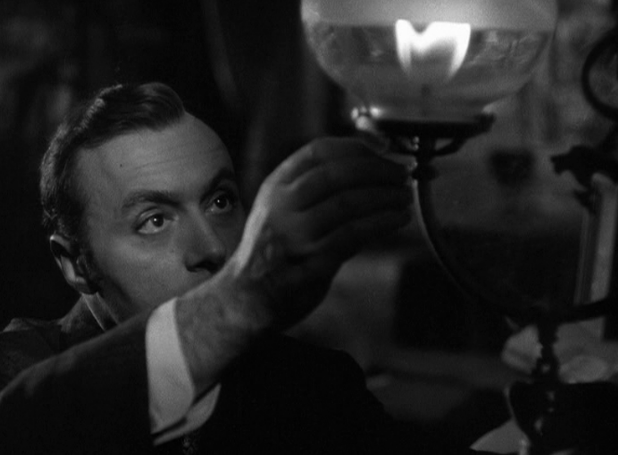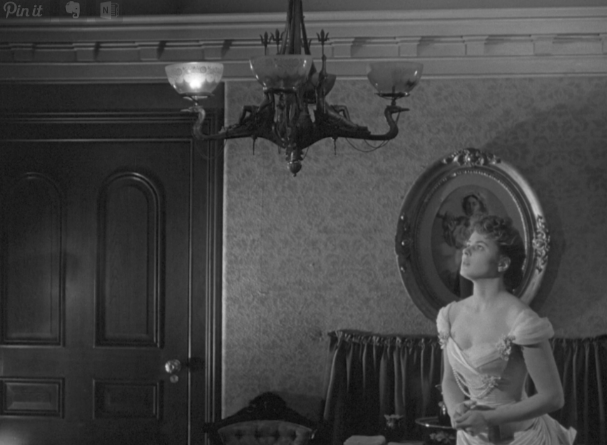But you might not make that shift. And that possibility is what the play “Gas Light” describes: the insecurity, hesitance, and forces that keep a person stuck. The word gaslight may be transformative, but there’s more to the story.
“Gas Light” shares basic plot elements with Gaslight the movie. The story revolves around Bella Manningham, whose husband mentally abuses her, making her uncertain if she is inheriting her mother’s madness. He unpredictably favors her, questions her logic, embarrasses her in front of their servants, threatens her. His signature move is to accuse her of misplacing things that he has hidden. When a detective visits Bella alone one evening, Jack Manningham’s past surfaces. He is in fact a wanted criminal, a murderer and jewel thief. Using Bella’s money, he had bought their house to conduct secret nightly searches for jewels that he believes are hidden there. Now that his wife has served her purpose, he can get her out of the way by having her committed.

Psychologists and sociologists are right to derive from this story a rich parable about abuse. They use gaslighting to refer to Jack’s mode of undermining Bella’s trust in herself in order to control her behavior. But where does the gaslight come in? Struggling to find etymological relevance, or an origin, a number of articles and a viral Tik-Tok have asserted that part of Jack’s behavior includes dimming the lights and then telling Bella she’s imagining it. As Rosemary Erickson Johnsen notes, however, this is not the case at all.
For Bella and Jack in 1880, gaslight is a utility. It requires attention. As Lily Bart illustrates with her match, it must be lit to illuminate the house at night, and the pressure shifts with its use across the pipeline. In the play, gaslight emerges as more than stage setting when the detective asks Bella about the footsteps she hears on the unused top floor of her house: whether she’s considered that they might belong to her husband, who misleadingly tells her he is going out each night. Her answer is yes:
“In this house, I can tell everything by the light of the gas. You see the mantle there. Now it’s burning full. But if an extra light went on in the kitchen or someone lit it in the bedroom then this one would sink down. It’s the same all over the house. . . . Every night, after he goes out, I find myself waiting for something. Then all at once I look round the room and see that the light is slowly going down. . . . Suddenly the light goes up again and ten minutes afterwards I hear his key in the lock and he’s back again” (36-37).
The account is remarkable. It clarifies that gaslight is the mystery’s tell, not the abuse’s instrument. More importantly, Bella’s words demonstrate that Jack’s insidious undermining of her confidence hasn’t permeated her entire mind. When she traces his use of the house’s gas line, she pits her logic against her husband’s testimony. She finds that her own thinking better explains the circumstances. He may say he’s going out, but her observation of the light says he’s just upstairs.
Dramatic as the reveal is, I’m more taken by what Bella’s perception of the gaslight doesn’t do. The gaslight helps her catch her husband in a lie. But it isn’t enough to undo the structure of doubt in which he’s caught her. As I’ve excerpted her dialogue above, Bella appears direct and assured, but she requires encouragement from the detective to relay what she has observed, and she isn’t clear about its implications. She begins with, “I don’t know what to say. It all sounds so incredible–” and “that is what I thought–but I thought I must be mad” (35). It’s only once the detective affirms her conjecture that she mirrors his conviction: “It’s true, then! It’s true. I knew it. I knew it!”
Knowing this one thing, however, does not result in greater comprehension of her husband, his strategies, or his history. As the detective unfolds these for her, her interjections are repeatedly uncertain: questioning, losing her place, unfocused. “What were you saying?” she replies. “But I don’t see—” “It’s all so confusing.”
For Bella, the gaslight indexes a moment of realization, a moment of certainty against the insecurity seeded by mental abuse. But it’s only a moment. Bella slides back into wariness, unsure of what she is learning, unsure of how to make sense of it. As Henry James wrote in 1880, one may expect such realizations to kindle into a blaze of activity, but sometimes they barely spark.
This is where the gaslights of “Gas Light” point us: not to the abuse itself, but to a moment of possibly suspending its hold. What do we call this flickering experience? How do we make space for both the moment and the haziness, for what is sandwiched between “I don’t know” and “But I don’t see—”?
And where does squinting through the haziness leave one? At the end of the play, the detective has arrested Jack and tied him up. But Bella’s world hasn’t righted itself. The play shows us so many other dimensions to her entrapment. The play’s stage directions repeatedly refer to her as “hysterical,” marking her as overly emotional and unhinged despite its ostensible investigation of that very premise. The detective is named Rough, and he doesn’t hesitate to handle her physically or, like Jack, say deliberately misleading things to her; in the last scene, he slaps her across the face.
George Cukor’s 1944 film adaptation constrains Bella’s character (called Paula, played by Ingrid Bergman) even further. The gaslights, in fact, aren’t all that elemental to the drama, because she doesn’t figure out their fluctuation at all. Many close-ups show Bergman’s face, petrified, looking up at the ceiling fixtures, wondering why they have shifted. It is the detective, not the abused wife, who explains their significance. Bella’s ambivalent agency vanishes completely.
These aspects of the texts aren’t identical to Jack’s manipulation, but they shore up his influence. They are the associates of his power, and they are never obliterated. If Bella can for once think her way around Jack, she can’t think her way to a world in which his abuse isn’t possible. That world does not exist. In some real way, Bella never gets out.
This is why, Elena Ruiz writes, “the greatest success of the gaslighting paradigm is that it provides cover for the structural dimensions of gaslighting” (688). She means that by focusing on interpersonal mental abuse or epistemic injustice, we excuse ourselves from analyzing the systemic cultural processes that underwrite them (689). In Bella’s case, these processes keep her moment of realization precarious. Bella can’t emerge from Jack’s insistence that she is hysterical, because Rough believes it too, and so does Patrick Hamilton, her very author. When she is adapted for film, she won’t even have a moment of realization.

I learned this week that gaslighting is Merriam-Webster’s word of the year, looked up frequently every single day. So I was not the only one puzzled by the catachresis of lamps becoming verbs.
Yet the trouble with gaslighting, it seems to me now, is what it leaves unsaid. Gaslighting is employed from a position of knowing what happened, of calling it out. It crowds out the not knowing, the hazy uncertainty, the insecurity. So often, we don’t know—as the manipulation is happening, after it happens, in a play, in real life, in 1880, in 2022. We may come to know, or we may not. We may say the word, or we may remain hesitant, our knowledge flickering even as we watch the lamplight shift.
In the last few weeks, I encountered a Starbucks employee, a fictional patient, and a colleague—all gaslit. They spoke about so much manipulation. But I want to dwell for a moment with those who don’t: with the realizations that may not spark, with the perceptions that remain entrapped. I want to think about who is quiet and attentive in the dimness.